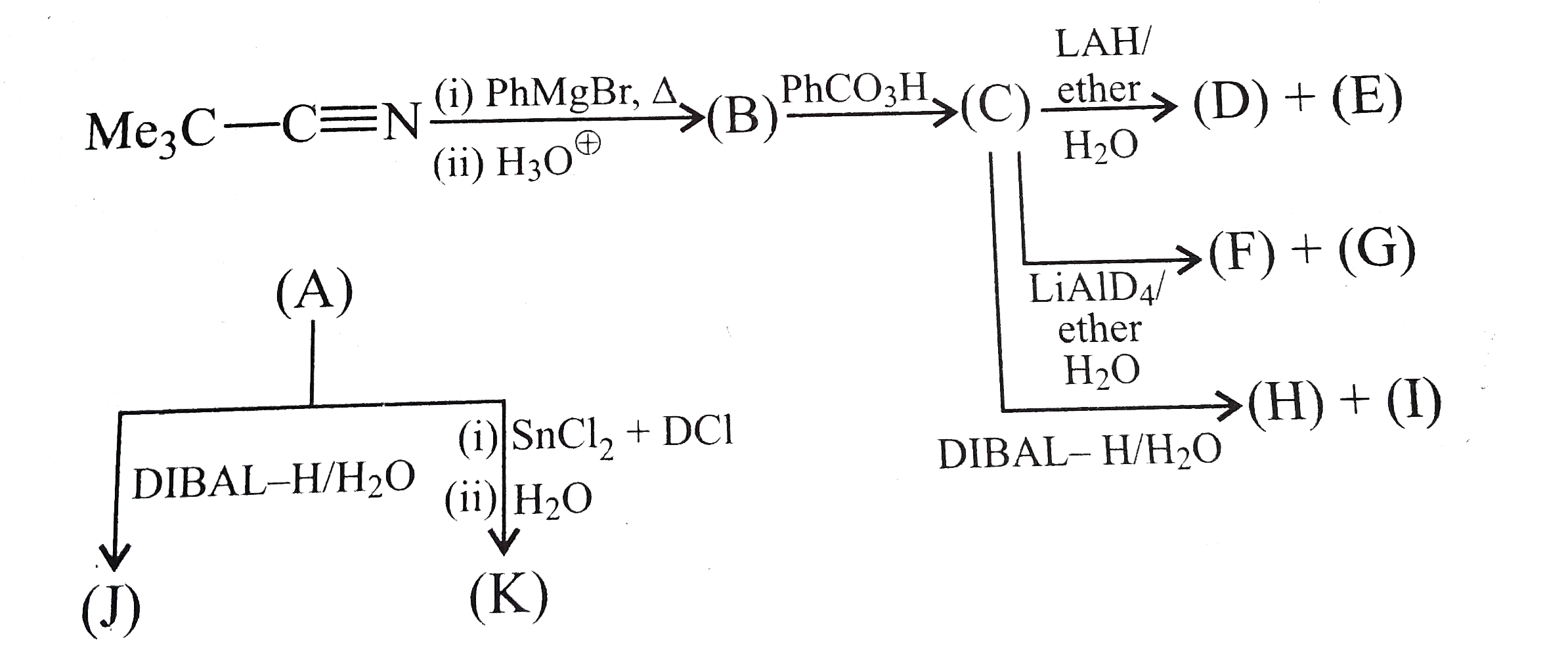
The compound (D) is:
Phenylhydrazone of (C )
Osazone of (C )
Both
None
The correct Answer is:B
Compound (A) has no (C−OH) group α to the (CH=O) group. So it forms only phenylhydrazone with 1mol of PhNHNH2.

(ii). Compound (B) has (C−OH) group α to the (CH=O) group. So it forms only osazone by reacting with 3molPhNHNH2.
∴3molPhNHNH2 reacts with 1mol(C). 1molPhNHNH2 reacts with 13mol(C).

Topper's Solved these Questions
- BIOMOLECULESBOOK - CENGAGE CHEMISTRY ENGLISHCHAPTER - BIOMOLECULESEXERCISE - Exercises (Multiple Correcttype)
30 Videos
- BIOMOLECULESBOOK - CENGAGE CHEMISTRY ENGLISHCHAPTER - BIOMOLECULESEXERCISE - Exercises (Single Correcttype)
80 Videos
- BIOMOLECULESBOOK - CENGAGE CHEMISTRY ENGLISHCHAPTER - BIOMOLECULESEXERCISE - Exercises (Concept Application)
25 Videos
- AROMATIC COMPOUNDS AND ALKYL AND ARYL HALIDES BOOK - CENGAGE CHEMISTRY ENGLISHCHAPTER - AROMATIC COMPOUNDS AND ALKYL AND ARYL HALIDES EXERCISE - Archives Subjective Type
4 Videos
- CARBOXYLIC ACIDS AND THEIR DERIVATIVESBOOK - CENGAGE CHEMISTRY ENGLISHCHAPTER - CARBOXYLIC ACIDS AND THEIR DERIVATIVESEXERCISE - Exercises Archives (Analytical And Descriptive)
34 Videos
Similar Questions
Twenty millilitres of a gaseous hydrocarbon (A) was exploded with excess of oxygen in eudiometer tube. On cooling, the volume was reduced by 50ml. On further treatement with KOH solution, there was a further contraction of 40 ml.

Compound (D) is:
View Solution
The compounds (D) and (E) respectively are:
View SolutionParagraph for problems 9−15

Compound (D) is:
View SolutionMatch each of the following four structures with one of the compound A-D on the basis of the following experimental facts
Compound (A),(B) and ( C ) are optically active, but compound (D) is not
Compound (C ) gives the same products as compound (D) on treatment with periodic acid, But compound (B) gives a different product.
Compound (A) does not react with periodic acid.

Compound A-D are respectively?
View SolutionA compound (A) on heating in Busen flame imparts brick red colouration. (A) on heating gives CO2 gas and a residue (B). The residue (B) when treated with water gives (c). On passing an excess of CO2 through (C) in water, a clear solution (D) is obtained. On boiling (D), compound (A) is reformed.
Compound (D) is
View SolutionBlack solid KOH+Air−−−−−−→Δ(A)(green)H2SO4−−−→(B)(purple)+(C)
(i) KI on reaction with alkali solution of (B) changes into a compound (D).
(ii) The colour of the compound (B) disappears on treatment with the acidic solution of FeSO4
(iii) With cold conc. H2SO4 compound (B) gives (E), which being explosive decomposes to yield (F) and oxygen. ltBrgt Q. Type of hybridization in compound (D) is:
View Solution(A) light blue coloured compound on heating will convert into black (B) which reacts with glucose gives red compound (C) and (A) reacts with ammonium hdyroxide in excess in presence of ammonium sulphate give blue compound (D). What is (A), (B), (C) and (D)?
View SolutionZnCI2+NaHCO3Heat−−→(A)Heat−−→(B)+(C)+H2O(B)+NaOH→(D)
Identify the compound (D) present in the solution.
View SolutionAn organic compound (A) C4H9Cl on reacting with aqueous KOH gives (B) and on reaction with alcoholic KOH gives (C ), which is also formed on passing the vapours of (B) over the heated copper. The compound (C ) readily decolourises bromine water. Ozonolysis of (C ) gives two compounds (D) and (E ). Compound (D) reacts with NH2OH to give (F) and compound (E ) reacts with NaOH to have an alcohol (G) and sodium salt (H) of an acid. (D) can also be prepared form propyne on treatment with water in the presence of Hg2+ and H2SO4. Identify (A) to (H) with proper reasoning.
View SolutionFour isomeric optically active compounds NaHCO3−−−−−→CO2(g)(A,B,C,D)(C4H8O3)
Compound (A)LAH−−→(E) (Archiral compound)
Compound (B)KMnO4−−−−−→orCrO3 Inert to oxidation.
Compound (C)−−−−−−−−→NaOI/H3O⊕CHI3(Yellowppt.)+Compound(F).
Compound (D) is :
View Solution
